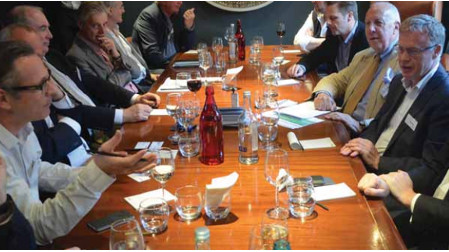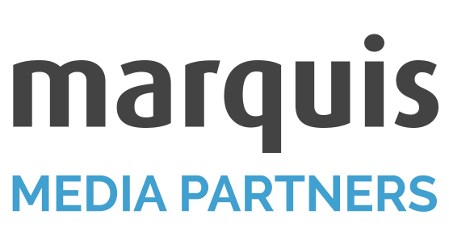Start 4K Now

The Groucho Club in London provided an exclusive setting for the debate
LONDON—Sitting down a group of broadcasting experts and asking them to deliver their advice on ultra HD guarantees plenty of passion and some controversy, and yet there was a strong sense of consensus by the end of the session. Chris Forrester moderated the roundtable discussion, hosted by Marquis Media Partners in conjunction with TVBEurope, during which panellists shared their views on 4K/ultra HD, when we might see transmission, and whether over-the-top will be the dominating driver for 4K availability.
The BBC’s Andy Baker summed up the industry challenges, saying: “Today, we have 4KTVs on every retailers shelves but there’s very little 4K content to display on them. The 4K content is being made but it’s certainly not being delivered except by one or two well known OTT suppliers.”
The IABM’s John Ive expressed the view that consumers had very little choice when buying into 4K. “They can choose a size but, as we saw with HDTV when after a while it was very difficult to get a standard definition set, I think the same is happening to 4K.”
The panel agreed that 4K in retail stores was now near ubiquitous, and that the price premium for (so-called) 4K sets was no longer a disincentive. But there was considerable discussion as to the capability of those displays to handle ‘true’ 4K, let alone cope with today’s fast-moving developments in higher frame rates, higher dynamic range and the ‘better pixel’ arguments likely from wider color gamut images.
BT’s Mark Wilson-Dunn said, in his view: “The material I have seen in 4K from the likes of Netflix is less than perfect. The danger for all of us is that people will buy into Netflix and think that’s as good as 4K can be, and it certainly is not. It could really backfire on all of us, given that they are buying panels at a huge rate and those panels really are not ready for what we all know as Ultra HD. And this isn’t helped by the fact that there’s no content out there. The other question that we all recognize is to ask how many of these buyers will be viewing 4K at the optimal viewing distance. There’s also the problem of the current crop of highly fashionable curved sets which, in my view, don’t help matters at all.”

The EBU’s Simon Fell argued that people were already making 4K ‘programming’ from their own smartphones.
“The end results are quite spectacular,” he said. “It is the same with still images. In other words, it’s very easy for consumers to be impressed by 4K displays but I think we are seeing something of an ‘emperor’s new clothes’ in that the display will look good to them, and their neighbors, no matter how close or far they are sitting from the screen. We would argue, of course, that we want improved frame rates and better resolution, but I can tell you the viewer is happy with what’s out there already.”
ITV’s Mark Smith said that the complete content delivery system needs to change.
“There’s storage for a start, than compression, and I can see us ending up with bandwidth for 4K not being that far off from today’s HD. However, while we can all agree that three years from now the technology will have improved, we still need to make that transition,” he said.
BT’s Wilson-Dunn reminded panelists that while agonizing over what might happen, there were broadcasters who had already made the switch. “There is a broadcasters who is running 4K today to a whole nation, and that’s Star TV in India, who started their service on the back of the ICC cricket earlier this year. BT carried the signals from Australia, running for eleven and a half hours a day in 4K and HD across two continents through to their set-top boxes. It can be done right now. We bolted four decoders together and ran the signals over our existing infrastructure. It coped. Add on HEVC and it would have coped even better. We have done football, rugby, golf, and now cricket. I have to say they all require different filming techniques to get the best out of 4K.
“The biggest issue we have, in my view, is that everyone is talking about high dynamic range and wider color gamut, instead of talking about how we can launch 4K and getting on with it. I think we risk confusing the message. The U.S. is having a problem getting over the ‘final mile’ of getting a signal into the home because of technical challenges. Meanwhile, a couple of Indian operators have just gotten on with it. We have to encourage the industry to get on with it otherwise we will all be waiting forever.”
NBC-Universal’s Tim Bertiloi said there was little interest from the U.S.’s main broadcast networks. “It is the usual challenge: where is the money coming from?”
His comments were echoed by Viacom’s Rod Fairweather, and not helped by his company’s focus on kids and music programming. “And even with the high-quality MTV Music Awards, I doubt whether you’ll see much 4K action for some time. We’re not going to lead this revolution.”
Globecast’s Francis Rolland said he expected France’s Canal+ and Orange to be leading the change to 4K, and as far as contribution and distribution services were concerned, Globecast was ready with extra bandwidth.
Asked to say when U.K. services would start, the panel agreed that certainly as far as the U.K. was concerned, within six months consumers would see lots of 4K channels. They unanimously expeted Sky to lead the charge.
Get the TV Tech Newsletter
The professional video industry's #1 source for news, trends and product and tech information. Sign up below.
